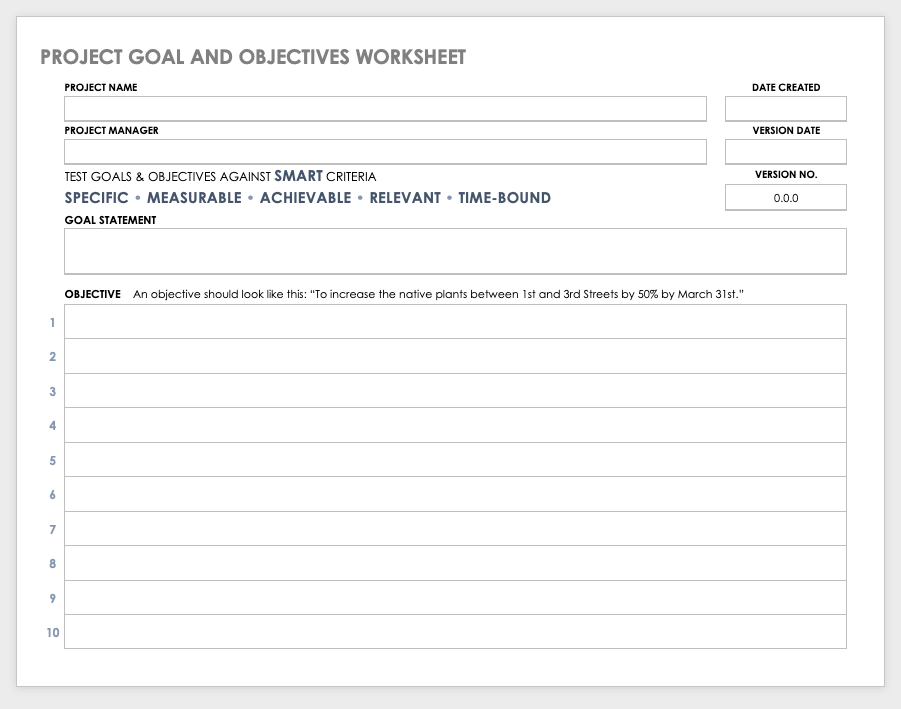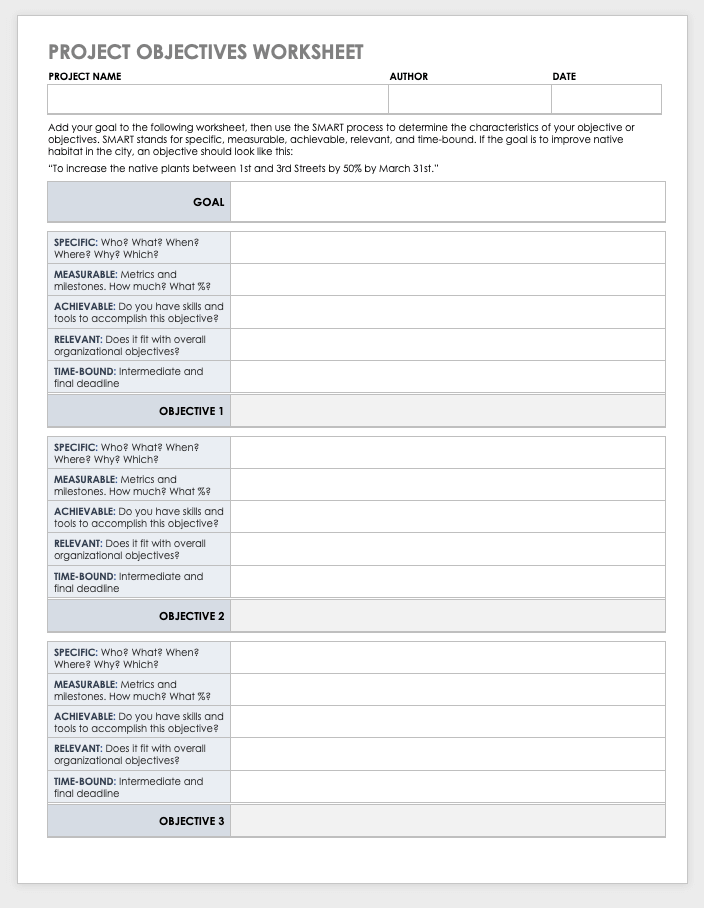What Is a Project Objective?
A project objective states the desired results of a project at its outset, including goals and deliverables. An objective should be specific and measurable, and identify any time, budget, and quality constraints.
Objectives can be used in project planning for business, government, nonprofit organizations, and even for personal use (for example, in resumes to describe the exact position a job-seeker wants). A project may have one objective, many parallel objectives, or several objectives that must be achieved sequentially. To produce the most benefit, objectives must be defined early in the project life cycle, in phase two, the planning phase.
Benefits of the Well-Written Objective
A well written objective is crucial because it can affect every step of the project life cycle. When you create a specific objective, you give your team a greater chance of achieving the objective because they know precisely what they’re working towards. Clear project objectives also support the current emphasis on total quality management: every member of the team can consider themselves responsible for quality, because the whole team can see the desired outcome from the beginning of the project.
All types of endeavors can benefit from objectives. As an individual, you may use an objective to target exactly what to plan for. For example, you may know you want to go to graduate school, but finding an objective will help you to understand that you want to obtain a sociology degree at your local community college and to graduate in six years. A small nonprofit group may use objectives to determine that success for a recycling education program is when 40 percent of households in a county request free composting buckets. A construction company might use objectives to keep a building project on schedule and within budget.
No matter what the project type, templates can make the job easier, from crafting the objective statements to planning the project.
Download Project Goal and Objectives Template
Download Project Objectives Worksheet Template
The Taxonomy of Project Definitions
You may encounter several definitions of objectives, such as vision statements and business goals. While these terms are often used interchangeably, we’ve outlined the relationships among them to help you use them correctly:
Vision Statement - A statement that expresses the high-level intention of a project (often with lofty or unachievable goals). For example, a school may aim for perfect pupil attendance or a company may strive for 100% customer satisfaction.
Business Goals - A company creates these to describe the overall outcomes it wants to accomplish in a certain time frame. Business goals are captured in business plans.
Goals - A high-level, broad, non-specific, and long-term definition of what the group or organization wants to accomplish. Goals are not measurable, and several discrete projects may be needed to achieve a goal. Some people say that project goals do not need to be defined, so long as a project manager understands the business goals. However, project objectives are always needed. In a business, project goals are influenced by business goals.
Objectives - Influenced by goals, an objective is a low-level description of the specific and measureable outcomes desired from a project. Activities and most likely deliverables will contribute to achieving the objective. The project and its objectives must always contribute to the goal, otherwise the project should not be attempted.
Bottomline: Goals are high-level, general statements about the aims of the project, while objectives are detailed statements about what the project should accomplish.
Activities - This is what your team will do to achieve the objective. An activity can be a specific action or a process, and many activities will likely be involved to meet objectives. As with everything in project management, the key consideration for activities is that they contribute directly to achieving the objective, and thereby the goal.
Deliverables - A specific, tangible product or thing, like a report or a software app. One or more deliverables may contribute to achieving an objective, but it is important not to define the objective as a deliverable. In other words, if the objective is written at too low a level, you risk creating the wrong deliverables. Rather, the objective is there to guide you and the team to determine what products or processes are needed. For example, say you have difficulty falling asleep each night. You may decide that your objective is to buy relaxing chamomile tea. Drinking the tea might help, but if your objective had been to ensure at least seven hours of sleep a night by the following month, you might have explored other solutions that would have greater benefits, such as making sure to get an hour of exercise every day.
Requirements - A description of features and functions. Objectives should not include features and functions.
How to Define S.M.A.R.T. Objectives
SMART objectives are specific, measurable, achievable, realistic, and time-bound. To write SMART goals, consider the key performance indicators (KPIs) that are specific to your business or project.
Specific: Define your objectives clearly, in detail, leaving no room for misinterpretation. Think of the five w’s (who, what, when, where, and why).
Measurable: State the measures and performance specifications you’ll use to determine whether you’ve met your objectives.
Achievable or Attainable: Choose objectives that the team has a reasonable expectation of successfully completing.
Realistic: Set objectives the project team believes it can achieve. Relevant objectives align with group or company goals.
Time-bound: Include the date or specific period by which you’ll achieve the objectives.
If you’re interested in creating S.M.A.R.T. goals, use our template as a guide.
Objectives and Indicators
In some project management guides, you may also find reference to objectives and indicators. This is a different way of expressing the S.M.A.R.T. criteria. An objective may be stated as, Children in x county shall read better. The indicators would be, 60 percent of children under age 13 read at the appropriate reading level for their age.
Best Practices for Writing Successful Project Objectives
A project objective should be a brief, one-sentence statement that includes actionable, measurable goals. We’ve outlined some best practices for writing a successful project objective below.
Keep in mind that an objective should not specify how something is done, and consider the context and guidelines the organization you’re writing for use.
Here are a few suggestions to help you as you write the statement:
- Write the objective before starting the project.
- Identify all objectives at the beginning.
- An objective cannot be written in isolation. Get support from all levels of the team. If the team doesn’t believe in the objective, they won’t work towards it and stakeholders won’t provide resources. If stakeholders disagree with the objective, work with them until you get a statement you can all stand behind.
- Be brief; it increases the chances of objectives being read and understood.
- Be clear; don’t give a list of options or a range of target numbers. Ask for what you need and what you expect.
- Use plain English, not jargon so everyone can understand your objective.
- Make sure your objectives are things you actually can control. For example, “I will send out 50 letters of interest by next week” describes something you can achieve. “I will book 15 jobs by next week” is not something you can control, because it’s up to someone else to hire you.
Examples of Project Objectives
Although project management guides and organizations differ on how specific the verbs used in an objective should be, all sources agree that an objective should be detailed to be effective. The following are examples of how not to and how to write an objective.
Poorly Written Objectives
- Personal: Earn more money.
- Personal: Go to university.
- Nonprofit: Help children read better.
- Business: Create a new app.
- Business: Install a new system.
Examples of Well Written Objectives
- Personal: Your goal may be to buy a house, but your objective is to get a condominium for under $250,000 with two bedrooms by August.
- Business: The goal is to build up the company in the near future. The objective is to increase sales of Super Widget by 10 percent by the second quarter of next year.
- Business: The goal is to make existing customers happier. The objective is to improve customer satisfaction rates by 50 percent by June 30 through training of customer service team.
- Nonprofit: The goal is to restore a native habitat around the retention pond near the Old Road to encourage native bird and animal species to visit and improve water filtration. The objective is to support residential homeowners around the pond to remove and replace non-native plants on one-third of the designated area by December.
- Nonprofit: The goal is to ensure that homeless women have access to regular meals. Three objectives can help accomplish this goal:
- Objective 1: To locate a kitchen and eating space on a bus route that can serve 30 women by December 15.
- Objective 2: To recruit volunteers who will staff the kitchen for breakfast and dinner by December 30.
- Objective 3: To organize a regular donated food supply for breakfasts and dinners from local organizations and restaurants by December 30.
Use Smartsheet to Create and Document Your SMART Goals
Empower your people to go above and beyond with a flexible platform designed to match the needs of your team — and adapt as those needs change.
The Smartsheet platform makes it easy to plan, capture, manage, and report on work from anywhere, helping your team be more effective and get more done. Report on key metrics and get real-time visibility into work as it happens with roll-up reports, dashboards, and automated workflows built to keep your team connected and informed.
When teams have clarity into the work getting done, there’s no telling how much more they can accomplish in the same amount of time. Try Smartsheet for free, today.

